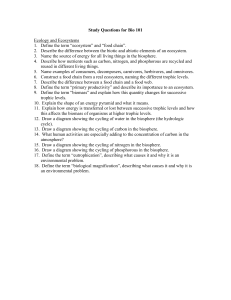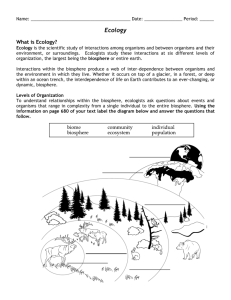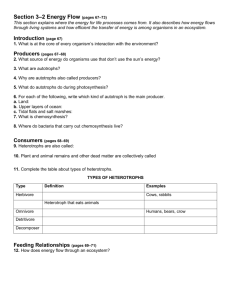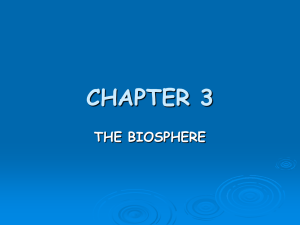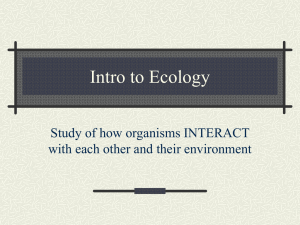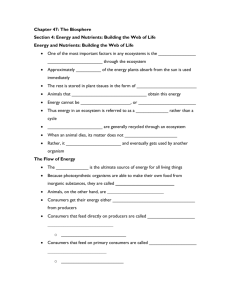Biology Chapter 3 Outline
advertisement
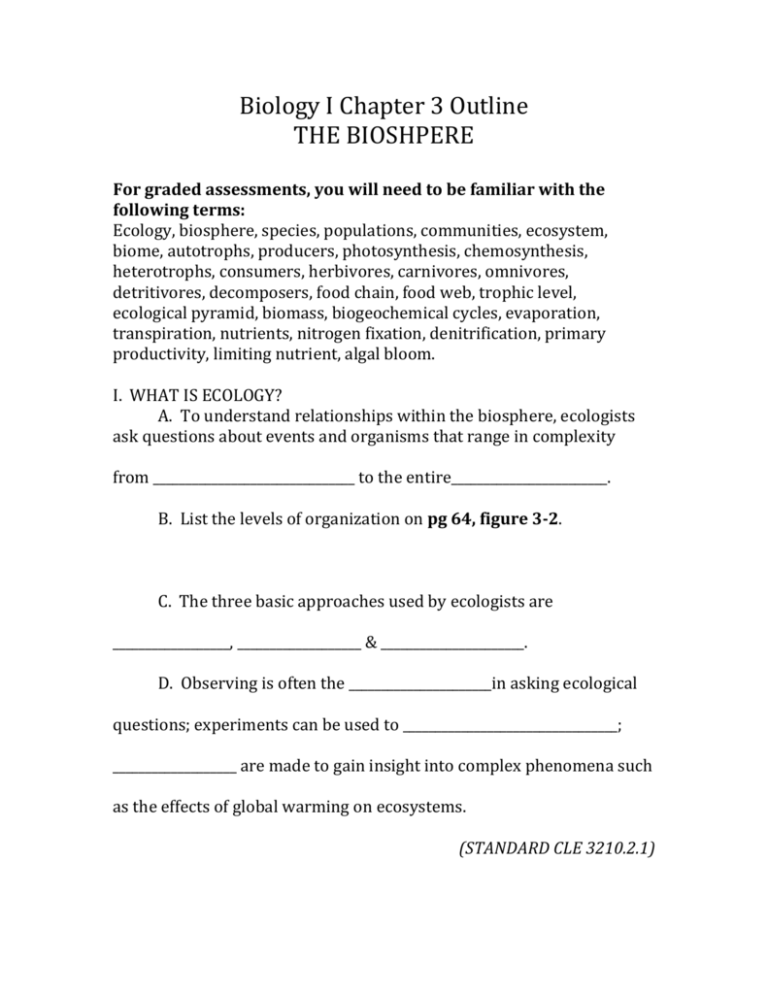
Biology I Chapter 3 Outline THE BIOSHPERE For graded assessments, you will need to be familiar with the following terms: Ecology, biosphere, species, populations, communities, ecosystem, biome, autotrophs, producers, photosynthesis, chemosynthesis, heterotrophs, consumers, herbivores, carnivores, omnivores, detritivores, decomposers, food chain, food web, trophic level, ecological pyramid, biomass, biogeochemical cycles, evaporation, transpiration, nutrients, nitrogen fixation, denitrification, primary productivity, limiting nutrient, algal bloom. I. WHAT IS ECOLOGY? A. To understand relationships within the biosphere, ecologists ask questions about events and organisms that range in complexity from _______________________________ to the entire________________________. B. List the levels of organization on pg 64, figure 3-2. C. The three basic approaches used by ecologists are __________________, ___________________ & ______________________. D. Observing is often the ______________________in asking ecological questions; experiments can be used to _________________________________; ___________________ are made to gain insight into complex phenomena such as the effects of global warming on ecosystems. (STANDARD CLE 3210.2.1) II. ENERGY FLOW A. ___________________ is the main energy source for life on Earth. Some types of organisms rely on the energy stored in _______________________________________. B. What is the difference between photosynthesis and chemosynthesis? Refer to page 68, figure 3-5 and note the differences between photosynthesis and chemosynthesis. Be able to give an example of an organism that uses chemosynthesis to synthesize nutrients. C. Know the direction that energy flows in an ecosystem. D. Understand the trophic levels illustrated on page 71, figure 3-8. List all 5 trophic levels shown. E. Only about _____________________ of the energy available within Trophic level is transferred to organisms at the next trophic level. List the three types of ecological pyramids and distinguish between them. (STANDARD CLE 3210.3.1) III. CYCLES OF MATTER A. Unlike the one-way flow of energy, ____________________ is recycled within and between ecosystems. Biogeochemical cycles are cycles in which elements, compounds and other forms of matter are B. What is the water cycle? C. Every living organism needs ____________________ to build tissues And carry out essential life functions. Like water, __________________are Passed between organisms and the environment thorough _______________________. D. Carbon is a key ingredient of living tissue. Please name and briefly describe the four main types of processes that move carbon through its cycle. ______________________________________________________________ E. Refer to page 77, figure 3-13 and be able to list at least 4 sources of Carbon in the biosphere.__________________________________________ __________________________________________________________________________________ F. What is the Nitrogen cycle?_________________________________________ Distinguish between nitrogen fixation and denitrification. ________________ What types of organisms are capable of fixing nitrogen and denitrifying? G. What is the Phosphorus cycle? ___________________________________ Where is most of the phosphorus stored in the biosphere? ___________________________________________________________________________________ H. ___________________________________of an ecosystem is the rate at which organic matter is created by producers. When an ecosystem is limited by a single nutrient that is scare or cycles very slowly, this substance is called a _______________________________________. When an aquatic ecosystem receives a large input of a limiting nutrient, ______________________occur. (STANDARD CLE 3210.3.4)
